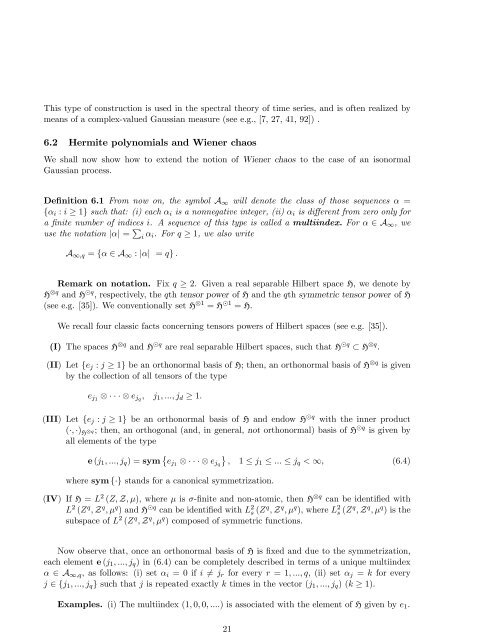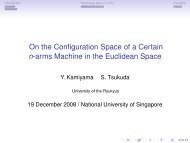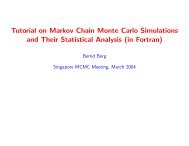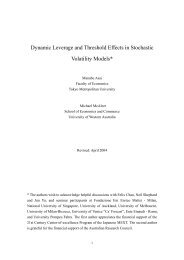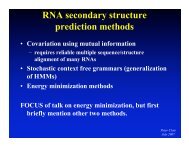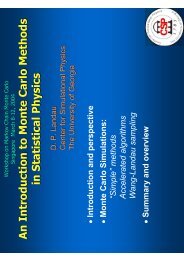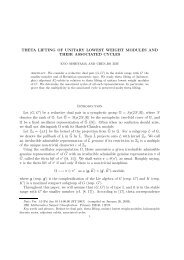Stein's method, Malliavin calculus and infinite-dimensional Gaussian
Stein's method, Malliavin calculus and infinite-dimensional Gaussian
Stein's method, Malliavin calculus and infinite-dimensional Gaussian
You also want an ePaper? Increase the reach of your titles
YUMPU automatically turns print PDFs into web optimized ePapers that Google loves.
This type of construction is used in the spectral theory of time series, <strong>and</strong> is often realized by<br />
means of a complex-valued <strong>Gaussian</strong> measure (see e.g., [7, 27, 41, 92]) .<br />
6.2 Hermite polynomials <strong>and</strong> Wiener chaos<br />
We shall now show how to extend the notion of Wiener chaos to the case of an isonormal<br />
<strong>Gaussian</strong> process.<br />
De…nition 6.1 From now on, the symbol A 1 will denote the class of those sequences =<br />
f i : i 1g such that: (i) each i is a nonnegative integer, (ii) i is di¤erent from zero only for<br />
a …nite number of indices i. A sequence of this type is called a multiindex. For 2 A 1 , we<br />
use the notation jj = P i i. For q 1, we also write<br />
A 1;q = f 2 A 1 : jj = qg :<br />
Remark on notation. Fix q 2. Given a real separable Hilbert space H, we denote by<br />
H q <strong>and</strong> H q , respectively, the qth tensor power of H <strong>and</strong> the qth symmetric tensor power of H<br />
(see e.g. [35]). We conventionally set H 1 = H 1 = H.<br />
We recall four classic facts concerning tensors powers of Hilbert spaces (see e.g. [35]).<br />
(I) The spaces H q <strong>and</strong> H q are real separable Hilbert spaces, such that H q H q .<br />
(II) Let fe j : j 1g be an orthonormal basis of H; then, an orthonormal basis of H q is given<br />
by the collection of all tensors of the type<br />
e j1 e jq , j 1 ; :::; j d 1:<br />
(III) Let fe j : j 1g be an orthonormal basis of H <strong>and</strong> endow H q with the inner product<br />
(; ) H q; then, an orthogonal (<strong>and</strong>, in general, not orthonormal) basis of H q is given by<br />
all elements of the type<br />
e (j 1 ; :::; j q ) = sym e j1 e jq , 1 j 1 ::: j q < 1; (6.4)<br />
where sym fg st<strong>and</strong>s for a canonical symmetrization.<br />
(IV) If H = L 2 (Z; Z; ), where is -…nite <strong>and</strong> non-atomic, then H q can be identi…ed with<br />
L 2 (Z q ; Z q ; q ) <strong>and</strong> H q can be identi…ed with L 2 s (Z q ; Z q ; q ), where L 2 s (Z q ; Z q ; q ) is the<br />
subspace of L 2 (Z q ; Z q ; q ) composed of symmetric functions.<br />
Now observe that, once an orthonormal basis of H is …xed <strong>and</strong> due to the symmetrization,<br />
each element e (j 1 ; :::; j q ) in (6.4) can be completely described in terms of a unique multiindex<br />
2 A 1;q , as follows: (i) set i = 0 if i 6= j r for every r = 1; :::; q, (ii) set j = k for every<br />
j 2 fj 1 ; :::; j q g such that j is repeated exactly k times in the vector (j 1 ; :::; j q ) (k 1).<br />
Examples. (i) The multiindex (1; 0; 0; ::::) is associated with the element of H given by e 1 .<br />
21


